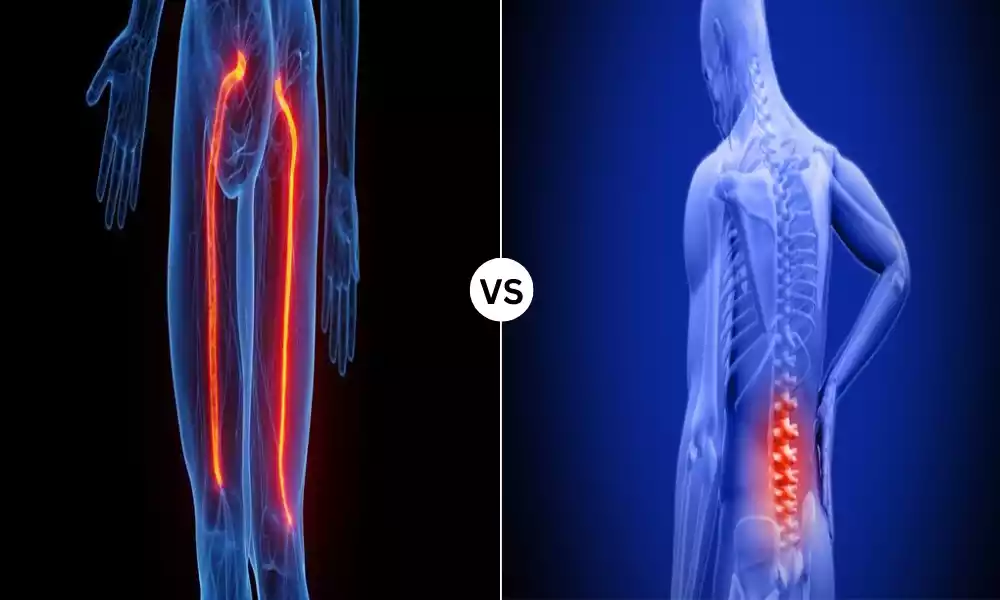Diarrhea is an incredibly common digestive disorder that is characterized by frequent loose and swollen bowel movements. Understanding the causes of diarrhea is essential for efficient treatment.
Osmotic and Secretory Diarrhea’s main types of diarrhea, called osmotic and secretory are distinct with respect to their treatments and mechanisms. We will examine the differences between the two types of diarrhea, including their definitions, and features in the clinical and diagnostic techniques and treatments, as the most important differences.
Explanation of Osmotic Diarrhea
Osmotic diarrhea is a form of diarrhea that is identified with the appearance of watery, loose stool that is caused by an overabundance of unabsorbed or poorly absorbed substances found in the digestive tract.
These substances draw water into the colon, which results in an increased volume of stool water and subsequent stool movements. Osmotic diarrhea usually improves when the intake of trigger substances is decreased or eliminated.
This disorder can be due to factors like malabsorption disorders, specific diet ingredients (e.g. lactose in lactose intolerance), or specific medicines that cause an osmotic influence within the digestive tract.

Explanation of Secretory Diarrhea
Secretory diarrhea is a form of diarrhea that is characterized by over-secretion of fluids into the intestines, resulting in the passing of stools that are watery.
Contrary to osmotic diarrhea which is mostly caused by the presence of unabsorbed substances in the gastrointestinal tract secretory diarrhea results from an overactive secretory system within the intestinal lining.
The overproduction of fluids impedes the capacity of the intestine to absorb electrolytes and water which causes frequent movement of a watery stool. The cause of diarrhea that causes secretory is usually due to various medical conditions, such as inflammation bowel diseases, infections, and hormonal imbalances.
It usually is not improved by diet or fasting on their own. The treatment focuses on addressing the root causes as well as regulating fluid and electrolyte balance to avoid dehydration.

Importance of understanding the differences
Knowing the distinctions between secretory and osmotic diarrhea is vital for a number of reasons:
- Accurate Diagnosis: The distinction between the two types of diarrhea is essential for health professionals to come up with the right diagnosis. The root causes and the mechanism are different, and a mistaken diagnosis could lead to ineffective treatment.
- The most effective treatment: Being aware of whether someone suffers from osmosis or other diarrhea can help determine the best treatment. Osmotic diarrhea usually responds to diet changes and treatment of the root cause. However, secretory diarrhea could require more specific treatment of the underlying issue and replacement of the fluid or electrolyte.
- Preventing Dehydration: Both kinds of diarrhea may lead to dehydration, however, the risks and strategies for managing them differ. Knowing the cause of diarrhea aids healthcare providers in developing a strategy to stop or treat dehydration more efficiently.
- Patient Education: People who are aware of the kind of diarrhea they’re experiencing are able to make informed choices regarding their diet and adherence to medication. This empowers them to play an active part in their health care.
- Effective Resource Allocation: Healthcare resources are used more effectively when the cause of diarrhea is accurately determined. Not-needed tests, treatments, and hospitalizations could be prevented.
- Studies as well as Epidemiology: For researchers as well as public health professionals knowing the distinctions between these types of diarrhea is crucial for determining the incidence of certain conditions developing specific interventions and analyzing how diarrhea affects people with disorders.
- Qualities of life: Properly managing diarrhea regardless of whether it’s osmotic, or secretory, will significantly enhance the quality of living. The best treatment options are tailored to minimize the discomfort and disruption that comes with frequent loose stool movements.
Understanding the difference between osmotic as well as secretory diarrhea is essential to a precise diagnosis, efficient treatment and prevention of complications, and better patient outcomes.
It plays an important role in clinical practice as well as public health initiatives that aim to reduce the incidence of diarrheal diseases.
Comparison Table of Osmotic and Secretory Diarrhea
Here’s a comparison table highlighting the key differences between osmotic and secretory diarrhea:
| Aspect | Osmotic Diarrhea | Secretory Diarrhea |
|---|---|---|
| Definition | Diarrhea resulting from poorly absorbed or unabsorbed substances in the intestines, leading to water retention in the bowels. | Diarrhea due to excessive secretion of fluids into the intestines, overwhelming absorption capacity. |
| Causes | Malabsorption syndromes, dietary components (e.g., lactose intolerance), and certain medications. | Infections, inflammatory bowel disease, hormonal imbalances, toxins, and some medications. |
| Stool Characteristics | Loose stools with a higher osmotic concentration, may improve with fasting. | Watery stools that do not improve with fasting. |
| Associated Symptoms | Often relief from diarrhea after fasting or reducing intake of the triggering substance. | Diarrhea persists regardless of dietary changes or fasting. |
| Diagnosis | High osmotic gap (greater than 50 mOsm/kg) in stool analysis, often responds to dietary modifications. | The normal osmotic gap in stool analysis may require measurement of fecal electrolytes. |
| Treatment | Address underlying causes (e.g., lactose-free diet), oral rehydration, and sometimes medications (e.g., anti-motility drugs). | Focus on correcting the underlying condition (e.g., antibiotics for infections), and fluid and electrolyte replacement. Medications may be used for symptom relief. |
| Examples of Causes | Lactose intolerance, celiac disease, certain laxatives. | Infectious agents (e.g., cholera), Crohn’s disease, VIPoma (Vasoactive Intestinal Polypeptide tumor). |
| Response to Fasting | Often improves with fasting or avoiding specific foods/substances. | Fasting typically does not alleviate symptoms. |
| Dehydration Risk | Moderate risk due to increased fluid loss. | High risk due to excessive fluid secretion. |
| Chronicity | May be chronic if the underlying condition persists. | Often related to acute conditions, but can be chronic if the underlying disorder remains untreated. |
This table provides a concise overview of the key differences between osmotic and secretory diarrhea, helping to differentiate these two types of diarrhea based on various characteristics, causes, diagnostic criteria, and treatment approaches.
Symptoms of Osmotic and Secretory Diarrhea
The symptoms of secretory and osmotic diarrhea can be similar to a certain degree since both kinds of diarrhea are associated with changes in bowel habits. There are specific signs and symptoms that are associated with each of them that assist in distinguishing between the two.
These are the symptoms of Osmotic and secretory diarrhea:
Symptoms of Osmotic Diarrhea:
- Loose stools: Osmotic diarrhea is usually manifested as a loose or dehydrated stool.
- More frequent: Osmotic diarrhea sufferers might experience regular bowel movements that are more frequent than the average.
- Abdominal Cramps: Moderate to mild abdominal discomfort or cramping is typical.
- Relief from fasting: The symptoms usually improve or disappear after eating a fast or avoiding certain foods or substances that cause the diarrhea.
- Bloating: A few people may suffer abdominal bloating because of the presence of unabsorbed substances or metabolites that are not properly absorbed within the digestive tract.
- Gas: Gas production that is excessive can cause osmotic diarrhea that can lead to flatulence.
- The causes of dehydration are: Osmotic diarrhea that is prolonged may lead to dehydration when the loss of fluid is not replaced.
Symptoms of Secretory Diarrhea:
- Watery Stools: Secretory diarrhea can be characterized by frequent, heavy, and swollen stools.
- No Relief from Fasting: Unlike osmotic diarrhea secretory diarrhea doesn’t generally improve after fasting or diet changes.
- Abdominal Cramps: Patients might suffer from abdominal cramps and pain similar to osmotic diarrhea.
- Urgent: The urge to get a bowel motion could be abrupt and urgent.
- Nocturnal Symptoms: Individuals suffering from secretory diarrhea might be awakened late at night to pass stool.
- Hydration: The condition of dehydration poses a major concern because of the high liquid loss that is associated with diarrhea that is secretory.
- Systemic symptoms: If caused by an underlying issue such as an inflammation of the bowel or an infection Secretory diarrhea could be caused by fatigue, fever as well as other signs that are related to the root reason.
It’s crucial to keep in mind that the exact symptoms and severity of the condition can differ in relation to the causes of diarrhea. The precise diagnosis and differentiation between secretory and osmotic diarrhea could require a medical evaluation along with stool analysis and other diagnostic tests to determine the cause of the problem and provide the appropriate treatment.
Osmotic diarrhea causes
Osmotic diarrhea is caused due to factors that result in the presence of poorly absorbed or not absorbed substances within the digestive tract. These substances pull fluid into the digestive tract, which results in watery and loose stools.
The most common causes of osmotic diarrhea are:
- Lactose intolerance: This is among the most frequent causes of Osmotic diarrhea. People who suffer from lactose intolerance are deficient in the enzyme lactase which is required to digest lactose, which is a sugar that is found in dairy products and milk. If they eat foods that contain lactose the sugar is not digested in the intestines, causing Osmotic diarrhea.
- Malabsorption Syndromes: Conditions that affect regular absorption of nutrition within the intestines may cause the condition known as osmotic diarrhea. Some examples include celiac disease (inability to eat gluten) and tropical sprue along with short bowel syndrome.
- Sorbitol and other sugar Alcohols: The sugar alcohols that are present like sorbitol or Mannitol, are not digested in the intestines. They may cause diarrhea and osmosis when consumed in large quantities. They are typically employed to sweeten sugar-free gums and candy.
- Magnesium-containing Antacids: A few over-the-counter anti-acids that contain magnesium may cause an osmotic impact on the intestines, causing diarrhea as a result.
- Medical Conditions: Certain medications, like laxatives (especially ones that contain magnesium), could cause osmotic diarrhea if used improperly or in excess.
- Artificial sweeteners: Some people may suffer from osmotic diarrhea as a result of artificial sweeteners, such as saccharin and aspartame.
- High-Fiber Diets: Although fiber can be beneficial to digestive health, eating large quantities of insoluble fiber could result in osmotic diarrhea in certain individuals.
- Fruit juices: Juices made of high-fructose fruits may cause osmotic diarrhea for those who are sensitive to fructose.
- surgery: A few types of digestive surgery, like gastric bypass, could alter digestion as well as absorption of nutrients which could lead to osmotic diarrhea.
- Some Infections: The presence of infections that interfere with the function of the intestines could temporarily lead to osmotic diarrhea until the infection has been eliminated.
It’s important to know that the treatment of Osmotic diarrhea usually involves finding and fixing the root causes. This could include diet modifications as well as lifestyle adjustments, and sometimes medications to ease symptoms or assist in digestion, based on the exact cause of the diarrhea. If the osmotic diarrhea is persistent or severe, it’s important to seek out a medical professional to ensure proper assessment and treatment.
Osmotic Secretory Diarrhea
There could be some ambiguity in your query. Secretory and osmotic diarrhea are distinct kinds of diarrhea, with distinct underlying mechanisms and underlying causes. They aren’t usually called “osmotic secretory diarrhea” together.
I’m able to offer an overview of the two conditions:
Osmotic Diarrhea:
- Reason: Osmotic diarrhea occurs when the intestines are contaminated with non-absorbed or poorly absorbed substances that are able to draw water into the intestinal tract, causing loose stool. The most common causes are malabsorption syndromes, lactose intolerance as well and the consumption of Osmotically active substances.
- Particularities: Stools in osmotic diarrhea are more osmotic which results in an increase in levels of water in the colon. This kind of diarrhea usually gets better by ensuring that the intake of factors that trigger it is cut down or eliminated.
- Response to fasting: Osmotic diarrhea symptoms could improve after fasting or avoiding ingredients that cause diarrhea.
- The treatment: Treatment involves addressing the root of the problem (e.g. the lactose-free diet to treat lactose intolerance) and occasionally using medications to control symptoms.
Secretory Diarrhea:
- Reason: Secretory diarrhea results due to an excessive secretion of bile in the intestines that overwhelms the body’s capacity to absorb these fluids. Common causes are inflammation of the bowel hormonal imbalances, and certain medications.
- The characteristics of HTML0: Stools in secretory diarrhea are swollen and profuse They are not usually improved by eating a diet or fasting.
- Response to fasting: Fasting doesn’t usually reduce symptoms of secretory diarrhea.
- The treatment: Management focuses on the underlying cause (e.g. antibiotics to treat infections) and fluid and electrolyte replacement to avoid dehydration and occasionally, medications to treat symptoms.
Osmotic diarrhea is caused by substances that draw water into the intestinal tract, whereas the secretory type of diarrhea results from excess fluids being released into the intestinal tract. Knowing the distinctions between the two kinds of diarrhea is vital for a correct diagnosis and the appropriate treatment.
Similarities Between Osmotic and Secretory Diarrhea
While osmotic diarrhea and secretory diarrhea can be described as two different forms of diarrhea that have different mechanisms, they share similarities between these two types of diarrhea:
- The watery Stools: Both osmotic and secretory diarrhea can result in loose stool that is watery. The consistency of stool is similar for both kinds and makes it difficult to distinguish between the two based on appearance.
- Abdominal Discomfort: Patients who suffer from both types of diarrhea might suffer from abdominal cramps or abdominal pain. The sensation of urgency as well as abdominal pain can be typical symptoms in both situations.
- Dehydration Risk: Osmotic and secretory diarrhea can result in dehydration if they are not treated appropriately. This risk can be caused by losing fluids due to frequent stool movements.
- Potential for Symptoms in the System: In severe cases or when diarrhea is triggered by other illnesses (e.g. infections, infections, or inflammatory bowel diseases) those suffering from the two types of diarrhea can suffer from systemic symptoms like the feeling of being fatigued, feverish, or weakening.
- Diagnostic Overlap: Clinically the distinction between osmotic as well as secretory diarrhea could require special diagnostic tests, because the symptoms may not always indicate the root cause.
- Response to treatment: The initial treatment approach differs between these two kinds (addressing the root of the osmotic diarrhea and replacing fluids for diarrhea caused by secretion) Both may require aid to electrolyte management and hydration.
It’s important to be aware of the major distinctions in the reasons and the responses to changes in diet or fasting in order to manage the symptoms of osmotic and secretory diarrhea successfully. A precise diagnosis is essential to determine the best treatment plan for every patient.
Reference Books
Certainly, here are some reference books across various genres and topics that cover a wide range of subjects.
These books are considered authoritative and informative in their respective fields:
- Science and Nature:
- “Cosmos” by Carl Sagan
- “A Brief History of Time” by Stephen Hawking
- “The Selfish Gene” by Richard Dawkins
- “Sapiens: A Brief History of Humankind” by Yuval Noah Harari
- Literature and Fiction:
- “To Kill a Mockingbird” by Harper Lee
- “1984” by George Orwell
- “Pride and Prejudice” by Jane Austen
- “One Hundred Years of Solitude” by Gabriel García Márquez
- Philosophy:
- “Meditations” by Marcus Aurelius
- “The Republic” by Plato
- “Critique of Pure Reason” by Immanuel Kant
- “Being and Time” by Martin Heidegger
- History:
- “A People’s History of the United States” by Howard Zinn
- “The Guns of August” by Barbara W. Tuchman
- “The Rise and Fall of the Third Reich” by William L. Shirer
- “Genghis Khan and the Making of the Modern World” by Jack Weatherford
Conclusion
A well-rounded selection of reference books that span a variety of disciplines and genres is useful for expanding knowledge, gaining a new perspective, and understanding many different subjects.
When it comes to exploring mysterious universes, delving into the history of our world, or delving into the deepest levels of human psychology, these books give access to the vast knowledge base and provide an opportunity for personal growth and intellectual development.
These books are not just informative but also enthuses which makes them vital guides on the journey of understanding and learning.







